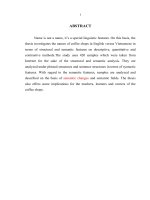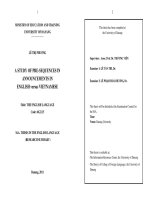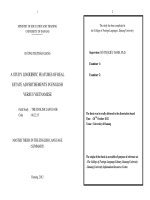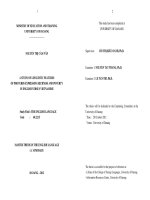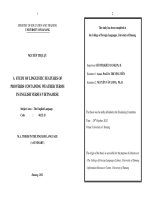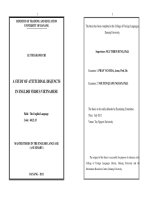Suggesting and responding to suggestions in English and Vietnamese
Bạn đang xem bản rút gọn của tài liệu. Xem và tải ngay bản đầy đủ của tài liệu tại đây (655.89 KB, 62 trang )
1
HAIPHONG PRIVATE UNIVERSITY
DEPARTMENT OF FOREIGN LANGUAGE
GRADUATION PAPER
SUGGESTING AND RESPONDING TO SUGGESTIONS IN ENGLISH
AND VIETNAMESE
By:
Nguyen Thu Trang
Class:
Na903
Supervisor:
Trinh Van Sach, M.A
HAIPHONG – JUNE 2009
2
CỘNG HOÀ XÃ HỘI CHỦ NGHĨA VIỆT NAM
Độc lập – Tự do – Hạnh phúc
o0o
BỘ GIÁO DỤC VÀ ĐÀO TẠO
TRƯỜNG ĐẠI HỌC DÂN LẬP HẢI PHÒNG
NHIỆM VỤ ĐỀ TÀI TỐT NGHIỆP
Sinh viên: Nguyễn Thu Trang …………………………… Mã số: 091162
Lớp: Na 903………………………………………… Ngành: Ngoại ngữ
Tên đề tài: Suggesting and responding to suggestions in English and Vietnamese.
3
NHIỆM VỤ ĐỀ TÀI TỐT NGHIỆP
1. Nội dung và các yêu cầu cần giải quyết trong nhiệm vụ đề tài tốt nghiệp (về
lý luận, thực tiễn, các số liệu cần tính toán và bản vẽ)
2. Các số liệu cần thiết để thiết kế tính toán
3. Địa điểm thực tập
4
CÁN BỘ HƯỚNG DẪN ĐỀ TÀI TỐT NGHIỆP
Người hướng dẫn thứ nhất:
Họ và tên: Trịnh Văn Sách
Học hàm, học vị: Thạc sĩ
Cơ quan công tác: Đại học dân lập Hải Phòng
Nội dung hướng dẫn: Suggesting and responding to suggestions in English and
Vietnamese.
Người dướng dẫn thứ hai
Họ và tên:
Học hàm, học vị:
Cơ quan công tác
Nội dung hướng dẫn:
Đề tài tốt nghiệp được giao ngày:… tháng….năm 2009
Yêu cầu phải hoàn thành trước ngày:… tháng….năm 2009
Đã nhận nhiệm vụ Đ.T.T.N Đã giao nhiệm vụ: Đ.T.T.N
Sinh viên Cán bộ hướng dẫn Đ.T.T.N
Hải Phòng, ngày …tháng….năm2009
HIỆU TRƯỞNG
5
PHẦN NHẬN XÉT TÓM TẮT CỦA CÁN BỘ HƯỚNG DẪN
1. Tinh thần thái độ của sinh viên trong quá trình làm đề tài tốt nghiệp
2. Đánh giá chất lượng Đ.T.T.N ( So vớI nộI dung yêu cầu đã đề ra trong nhiệm
vụ Đ.T.T.N trên các mặt ly luận, thực tiễn , tính toàn giá trị sử dụng, chất lượng các
bản vẽ)
3. Cho điểm của cán bộ hướng dẫn:
Hải Phòng, ngày ….tháng….năm 2009
Cán bộ hướng dẫn chính
(Họ tên và chữ kí)
6
NHẬN XÉT ĐÁNH GIÁ CỦA CÁN BỘ CHẤM PHẢN BIỆN ĐỀ TÀI TỐT
NGHIỆP
1. Đánh giá chất lượng đề tài tốt nghiệp về các mặt thu nhập và phân tích số liệu
ban đầu, cơ sở lý luận chọn phương án tối ưu, cách tính toán chất lượng thuyết
minh và bản vẽ, giá trị lý luận và thực tiễn để tài.
2. Cho điểm của cán bộ phản biện
(Điểm ghi bằng số và chữ)
Ngày….tháng….năm 2009
Người chấm phản biện
7
ACKNOWLEDGEMENTS
I am indebted to many beloved people for their providing me incentive and
support during the time that I was writing this graduation paper. Firstly, I would
like to express my sincere gratitude to my supervisor, Mr. Trinh Van Sach (M.A)
at the Foreign Language Department of Hai Phong Private University for his
various materials, constant support, advice and valuable comments on draft
chapters to complete this study.
I also offer my sincere thanks to Ms. Tran Thi Ngoc Lien, Dean of Foreign
Language for her help and instructions.
Finally yet importantly, my wholehearted thanks are presented to my
family and all of my friends for their constant support and encouragement in the
process of doing this research paper.
Hai Phong, June, 2009.
Nguyen Thu Trang
8
TABLE OF CONTENTS
ACKNOWLEDGEMENTS
TABLE OF CONTENT
PART I: INTRODUCTION………………………………………………………3
1. Rationable………………………………………………………………… 3
2. Aims of the study……………………………………………………………3
3. Scope of the study………………………………………………………… 4
4. Methods of the study……………………………………………………… 4
5. Design of the study………………………………………………………….4
PART II: DEVELOPMENT…………………………………………………… 6
Chapter 1: THEORETICAL BACKGROUND…………………………………6
I. Language and communication………………………………………………….6
1. Language…………………………………………………………………… 6
1.1 What is language? ………………………………………………………….6
1.2 Language in society…………………………………………………………6
2. Communication…………………………………………………………… 7
2.1 What is communication…………………………………………………….7
2.2 Function of communication……………………………………………… 7
2.3 Types of communication……………………………………………………9
II. Speech acts…………………………………………………………………….10
1. Definition………………………………………………………………… 10
2. Levels of speech acts……………………………………………………… 11
3. Communicative and coventional speech acts……………………………….13
4. Types of speech acts……………………………………………………… 14
5. Direct, indirect and nonliteral speech acts. ……………………………… 16
6. Philosophical importance of speech act theory…………………………… 21
III. Politeness…………………………………………………………………… 22
1. Definition………………………………………………………………… 22
2. Strategies of Politeness…………………………………………………… 23
9
Chapter II: SUGGESTING AND RESPONDING TO SUGGESTION…… 28
I. Suggesting and responding to suggestions in English. …………………… 28
1. Making suggestions in English…………………………………………….28
Direct suggestions……………………………………………………29
Indirect suggestions………………………………………………….32
2. Responding to suggestions in English…………………………………… 33
Acceptance………………………………………………………… 33
2.1.1. Definition of acceptance to suggestions…………………………33
2.1.2. Types of acceptance to suggestions…………………………… 33
2.2. Rejection……………………………………………………………….36
2.2.1. Definition of rejection to suggestions………………………… 37
2.2.2. Types of rejections…………………………………………… 37
2.2.3 Models of rejecting sentences to suggestions………………… 39
II. Suggesting and responding to suggestions in Vietnamese………………….40
1. Making suggestions in Vietnamese………………………………………….40
1.1. Direct suggestions…………………………………………………….40
1.2. Indirect suggestions………………………………………………… 41
2. Responding to suggestions in Vietnamese……………………………………41
2.1. Acceptance…………………………………………………………… 41
2.2. Rejection………………………………………………………………44
III. The similaries and differences between English and Vietnamese in
suggesting and responding to suggestions
1. Suggestions…………………………………………………………………… 47
2. Responses……………………………………………………………………….47
2.1. Acceptance………………………………………………………………….47
2.2. Rejection……………………………………………………………………48
Chapter III: FINDINGS……………………………………………………….49
PART III: CONCLUSION………………………………………………………50
I. Summary of the study……………………………………………………… 50
II. Suggestions for further research………………………………………… 50
ATTACHMENT…………………………………………………………………52
10
PART I : INTRODUCTION
1. Rationale:
English is one of the most widely used languages worldwide when being used
by over 60% the world population. It‟s used internationally in business, political,
cultural relation and education as well. Thanks to widespread use of English, diffirent
country come close to each other to work out the problems and strive for a prosperous
community.
Suggestion and response are also the part of communication.
Discussing about the suggestion and response in communicating, Wall [12:126]
says: “Most of our living includes suggesting and responding to suggestions”. People
have many reasons and chance to give suggestion.
Being a student of Foreign Language Faculty with four years learning at the
university, I have chance to equip myself with the knowledge of many fields in society
such as: sociology, economy, finance, culture, etc… With the knowledge gained from
the professional teachers, specialized books, references and with the helf of my
friends, the experience gained at the trainning time, I have put my mind on theme:
“Suggesting and responding to suggestions in English and Vietnamese” for my
graduation paper.
2. Aims of the study:
For the above-mentioned reasons this paper mainly focus on studying the
suggesting and responding to suggestion especially the ways of using and
understanding this phenomenon properly. Follow in this trend, the study will serve
purposes:
To present the usage of suggestions and responding to suggestions in English
and Vietnamese.
To help people understand about the similaries and differences between English
and Vietnamese in making suggestions and giving responses.
11
To provide some expressions on suggesting and responding to suggestions in
English and Vietnamese.
3. Scope of the study
In English, there are a lots of interesting aspects of communication to study.
However, suggesting and responding to suggestions is often used in our daily
conversations, that‟s why, it‟s the most fantastic field I have decided to study for my
graduation paper.
Due to the limitation of time and knowledge of the study field, my study
introduces and gives discussion as much as possible about definition, classification
and usage of suggestions and responses. Besides, in the second part of this paper I also
discuss politeness and speech acts as the theoretical background for my study of
suggestions and responses.
4. Methods of the study
In order to get data for the study and analysis in my paper, three ways are
deployed and used for data collection. First, data are collected from specific
suggsestions and responses presented in the materials and textbooks used for teaching
and learning English, English for special purposes in Vietnamsese Universities and
colleges. Second, they are obtained from discussions with my supervisor, from internet
and other sources. Third, through my own observation and informal dicussions with
foreigners. Then the data will be analyzed and arranged for dicussion according to the
set aims.
5. Design of the study
The study is divided into three main parts of which the second one is the most
important part.
Part one is introduction that gives out the rationale for choosing the topic of this
study, the aims, scope as well as methods of the study.
Part two is develpoment that consists of three chapters:
12
The first chapter aims at providing theoretical background for the study,
which is mainly brief introduction of language, communication,
politeness and speech acts.
The second chapter studies suggesting and responding to suggestions”.
This is the most important part in my graduation paper.
The third chapter refers to some findings and implication of the study.
Part three is the conclusion of the study, in which all the issues mentioned in
previous parts of the study are summarized.
13
PART II: DEVELOPMENT
Chapter I: Theoretical Background
I. Language and communication
1. Language
What is language?
Language is used to communicate and convey meaning from one person to
another. Language has rules which involve word structure (morphology), grammar
and sentence structure (syntax), word meaning (semantics) and social appropriateness
(pragmatics).
Some linguists who focus on these aspects of language spend years in the field
investigating previously unstudied languages, many of which are now on the verge of
extinction. By studying the properties of languages from around the world, linguists
hope to better understand properties shared by all human languages and the ways in
which languages can differ. That is, their goal is to understand the nature of human
language - how language "works."
1.2 Language in society
Language use is an inherently social phenomenon. How you speak depends on
such factors as where you grew up, your racial and ethnic identity, whether you are a
woman or man, and your education. That is, you use the variation in language as a
creative means of expressing who you are (and who you are not). By studying this
variation, researchers enhance their understanding of language as well as their
understanding of social processes, and discover the social factors that influence our
linguistic choices and how these choices are perceived by others. Linguists who study
the social aspects of language also investigate such topics as how and why languages
change over time, how new languages are created when speakers of divergent
languages come into contact, how language attitudes are used to maintain forms of
discrimination, how conversations are social transactions, the relation between
language and power, and the use of language in the media.
14
(
2. Communication
2.1 What is communication?
Communication is the process of transferring information from one source to
another. Communication is commonly defined as "the imparting or interchange of
thoughts, opinions, or information by speech, writing, or signs".
Communication can
be perceived as a two-way process in which there is an exchange and progression of
thoughts, feelings, or ideas towards a mutually accepted
goal or direction
Communication as an academic discipline has a long history.
Communication is a process where by information is encoded and imparted by a
sender to a receiver via a channel/medium. The receiver then decodes the message and
gives the sender a feedback. Communication requires that all parties have an area of
communicative commonality. There are auditory means, such as speaking, singing and
sometimes tone of voice, and nonverbal, physical means, such as body language, sign
language, paralanguage, touch, eye contact, by using writing.
Communication is thus a process by which we assign and convey meaning in an
attempt to create shared understanding. This process requires a vast repertoire of skills
in intrapersonal and interpersonal processing, listening, observing, speaking,
questioning, analyzing, and evaluating. If you use these processes it is developmental
and transfers to all areas of life: home, school, community, work, and beyond. It is
through communication that collaboration and cooperation occur.
2.2 Function of communication
“Treat a man as he is and he will remain as he is. Treat a man as he can and
should be and he will become as he can and should be.” ~ Goethe
Communication satisfies most of our needs: physical, identity and social
Physical
15
◊ People who lack strong relationships have 2 - 3 times the risk of early death,
regardless of whether or not they smoke or drink.
◊ Terminal cancer strikes socially isolated people more often than those who have
close personal relationships.
◊ Divorced, separated, and widowed people are 5 - 10 times more likely to need
hospitalization for mental problems than their married counterparts.
◊ Pregnant women under stress and without supportive relationships have three times
more complications than pregnant women who suffer from the same amount of stress
but have strong social support.
◊ Studies show that social isolation is a major risk factor contributing to coronary
disease, comparable to physiological factors such a s diet, smoking, obesity an lack of
physical activity socially isolated people are four times more susceptible to the
common cold than those who have active social networks.
Identity
Communication helps humans to define who they are. In other words, it is how
we communicate with others that helps us formulate the parameters of our identity.
When you speak are you honest or always sarcastic? Do you acknowledge others when
you speak or diss them by walking out when you don't like the way a conversation is
going? Consider the famous feral children who grew without human contact and the
following excerpt taken from Understanding Human Communication.
Some scholars have argued that we are most attracted to people who confirm our
identity. This confirmation can come in different forms, depending on the self-image
of the communicator. People with relatively high self-esteem seek out others who
confirm their value and, [ ] avoid those who treat them poorly. Conversely,people
who regard themselves as unworthy may look for relatiohships in which others treat
them badly. This principle offers one explanation for why some people maintain
damaging or unsuccessful relationships.
16
Social Needs
Researchers have identified several social needs that are statisfied through
communication: affection, inclusion, escape, relaxation and control. These are needs
that must be filled, and only communication with others can satisfy that need.
Anthropologist Walter Godldschmidt terms the communication drive as the "human
career."
Besides, communiation has other fuctions like: give personal information; ask
for personal information; introduce family and close friends; tell the time/day, etc; ask
the time/day; express ability enquire about ability; say when you do not understand;
ask for clarification; check back; correct; spell words aloud; describe places and
things; give information, as part of a simple explanation; give single-step directions
and instructions; make requests – ask for directions; enquire about prices and
quantities; make requests – ask for something; make requests – ask someone to do
something; respond to a request; express likes and dislikes; express feelings; express
wishes; express views; agree and disagree; apologise; express a preference; express
thanks; greet; respond to greetings; describe health and symptoms; invite and offer;
accept; decline; take leave.
2.3 Types of communication
Every time we speak, we choose and use one of four basic communication styles:
assertive, aggressive, passive and passive-aggressive.
a. Assertive Communication
The most effective and healthiest form of communication is the assertive style. It‟s
how we naturally express ourselves when our self-esteem is intact, giving us the
confidence to communicate without games and manipulation.
When we are being assertive, we work hard to create mutually satisfying solutions. We
communicate our needs clearly and forthrightly. We care about the relationship and
strive for a win/win situation. We know our limits and refuse to be pushed beyond
17
them just because someone else wants or needs something from us. Surprisingly,
assertive is the style most people use least.
b. Aggressive Communication
Aggressive communication always involves manipulation. We may attempt to make
people do what we want by inducing guilt (hurt) or by using intimidation and control
tactics (anger). Covert or overt, we simply want our needs met - and right now!
Although there are a few arenas where aggressive behavior is called for (i.e., sports or
war), it will never work in a relationship. Ironically, the more aggressive sports rely
heavily on team members and rational coaching strategies.
c. Passive Communication
Passive communication is based on compliance and hopes toavoidconfrontation at all
costs. In this mode we don‟t talk much, question even less, and actually do very little.
We just don‟t want to rock the boat. Passives have learned that it is safer not to react
and better to disappear than to stand up and be noticed.
d. Passive-Aggressive Communication
A combination of styles, passive-aggressive avoids direct confrontation (passive), but
attempts to get even through manipulation (aggressive). If you‟ve ever thought about
making that certain someone who needs to be “taught a thing or two” suffer (even just
a teeny bit), you‟ve stepped pretty close to (if not on into) the devious and sneaky
world of the passive-aggressive.
II. Speech acts
1. Definition:
Speech acts are a staple of everyday communicative life, but only became a
topic of sustained investigation, at least in the English speaking world, in the middle of
the twentieth Century. Since that time, “speech act theory” has been influential not
only within philosophy, but also in linguistics, psychology, legal theory, artificial
intelligence literary theory and many other scholarly disciplines. Recognition of the
importance of speech acts has illuminated the ability of language to do other things
18
than describe reality. In the process the boundaries among the philosophy of language,
the philosophy of action, the philosophy of mind and even ethics have become less
sharp.
We perform speech acts when we offer an apology, greeting, request,
complaint, invitation, compliment, or refusal. A speech act is an utterance that serves a
function in communication. A speech act might contain just one word, as in “Sorry” to
perform an apology or several words or sentence “I‟m sorry I for got your birthday. I
just let it slip my mind. Speech acts include real-life interactions and require not only
knowledge of the language but also appropriate use of that language within a given
culture.
Here are some examples of speech acts we use everyday.
Greeting: “Hi, Eric. How are things going?”
Request: “Could you pass me the mashed potatoes, please?”
Complaint: “I’ve already been waiting three weeks for the computer, and I was told it
would be delivered within a week.”
Invitation: “We’re having some people over Saturday evening and wanted to know if
you’d like to join us.”
Compliment: “Hey, I really like your tie.”
Refusal: “Oh, I’d love to see that movie with you but this Friday just isn’t going to
work.”
2. Levels of speech acts
Austin identifies three distinct levels of action beyond the act of utterance itself.
He distinguished the act of saying something, what one does in saying it, and what one
does by saying it, and dubs these the “locutionary”, the “illocutionary” and the
“perlocutionary” act, respectively suppose, for example, that a bartender utters the
words; “the bar will be closed in five minutes, reported by means of direct quotation.
He is there by performing the locutionary act of saying that the bar (ie. The one he is
19
tending) will be closed in five minutes (from the time of utterance) and what is said is
reported by indirect quotation (notice that what the bartender is saying, the content of
his locutionary act, is not fully determined. There are three levels of speech acts,
which are:
Locutionary (what is said)
Illocutionary (what is being done in the saying of it)
Perlocutionary (the effect the speaker has on the listener “by” or “through” the
saying of it.
2.1 Locutionary act
A locutionary act tells you something that you can understand or interpret
within a context to which the speaker has alerted you. Example, "You got an A in the
course." The speaker would have needed to identify the context, i.e. which course, and
which semester, which college, and whether the A was for the course or for some work
you did in the course.
"This is the act of saying something with a certain meaning, where words are uttered
with a more or less definite sense and reference." At p. 7-8 of pdf file. International
Commentary on Evidence Vol. 4, No. 2, Article 1.
2.2 Illocutionary act
“The locutionary act, as we saw, is the act of saying something. There is, secondly,
the illocutionary act; this is the act performed in saying something. We now shift our
attention from the meaning of a sentence to its force. To perform a locutionary act is
ipso facto to perform as well an illocutionary act. But a meaningful sentence can be
uttered with different forces. To use Searle‟s example, the sentence „I am going to do
it‟ has one literal meaning (orpropositional content) but can have the force of any one
or more of a variety of illocutionary acts; the utterance can amount to a promise, a
prediction, a threat, a warning, a statement of intention and so forth. (Footnote 32
omitted.) At p. 11of pdf file. International Commentary on Evidence Vol. 4, No. 2,
Article 1.
20
"The thoughts, feelings or behaviour of others are frequently affected by our
utterances. I may, by the use of language, achieve the consequential effect of
convincing or deterring or shocking you. In saying „Don‟t do it‟ (a locutionary act), I
could be advising you not to do it (an illocutionary act) and if you are persuaded by me
not to do it, that is the perlocutionary effect of my illocutionary act.38 My utterance
may not achieve the intended effect. It does not when, for example, you refuse to obey
my command. The intended effect is one thing, the actual effect is another."
2.3 Perlocutionary act
"Perlocutionary act and illocutionary point: the consequential effect of a verdict:
First, „to say something is to do something‟ (executing a locution, the act of saying
something), and secondly, „in saying something, we do something‟ (performing an
illocution). Now we come to the third: „by saying something, we do something‟
3. Communicative and conventional speech acts
Communicative speech acts address an audience in order to get them to do
something; their success depends on the audience recognizing the speaker‟s intentions.
Conventional speech acts do not depend on the reaction of an audience: they are
the ritual acts of marrying, christening, judging, and so on. They identify four types of
communicative speech acts – constatives (also borrowed from Searle)
ancknowledgements (Austin‟s behabilities, Searle‟s expressives) and 2 types of
conventional speech acts verdictives (based on Vendler‟s operatives).
3.1 Communicative speech acts
Constatives: affirming, alleging, announcing, answering, attributing, claiming,
classifying, concurring, confirming, conjecturing, denying, disagreeing, disclosing,
disputing, identifying, informing, insisting, predicting, ranking, reporting, stating,
stipulating.
Directives : advising, admonishing, asking, begging, dismissing, excusing,
forbidding, instructing, ordering, permitting, requesting, requiring, suggesting, urging,
warning.
21
Commissives : agreeing, guaranteeing, inviting, offering, promising, swearing,
volunteering.
Acknowledgments : apologizing, condoling, congratulating, greeting, thanking,
accepting (acknowledging an acknowledgment.
3.2 Conventional speech acts
Effectives: Speech acts effecting a change of status, including appointing,
nominating, suspending, demoting, resigning, abdicating, arresting.
Verdictives: Speech acts pronouncing judgment, including acquitting,
certifying, disqualifying, clearing, ruling, adjudicating.
4. Types of speech acts
In the cause of defining speech acts, Austin offered some rough general
categories for them; these categories have been argued over, modified, expanded and
redefined by several scholars since. For the constative pragmatician, it is essential to
boil the complexity of speech act types, and each speech act theorist who has
pronouned on the subject has had his or her own list, supposedly much better than all
the rest: clearer, simpler, more all-inclusive.
Constative pagmaticians keep trying, through and mostly keep trying to fit
everything into five airtight categories, the most famous revision of Austin‟s
taxonomy and the one that many constative pragmaticians take to be the final solution
the problem, is John Searle‟s in his 1969 book Speech Acts. Searl keeps Austin
categories of commissive, changes the expositives to representatives and the
declarations (what Vendler caleed operatives) which were strangely missing from
Austin‟s list. He also finds a place for suggestions, under directives:
4.1 Expresentatives
Represent a state of affairs: assertions, statements, claims, hypotheses, descriptions,
suggestions.
For example: Pragmatic studies meaning in interaction.
22
Austin lectured in Havard.
Performatives may be implicit.
4.2 Directives
Intented to get the addressee to carry out an action: commands, requests, challenges,
invitations, entreaties.
For example: Please ask your questions during the break.
Please submit your final assignments on time.
Don’t plagiarize.
4.3 Commissives
Commit a speaker to a course of action: promises, pledges, threats and vows.
For example: I will reply to your messages as soon as I can.
I will give you my comments about your final assignments.
I will help you with your transcripts.
4.4 Expressives
Indicate the speaker‟s psychological state or attitude: greetings, apologies,
congratulations, condolences, thanks-giving.
For example: I am sorry I haven’t done it yet.
Great new!
Congratulations!
4.5 Declarations
Bring about the state of affairs thy name: bleeings, firings, baptisms, arrests,
marryings.
For example: I declare you husband and wife
I christen this ship “Victory”.
23
But some of these seem a bit change. Apologizing, prasing, congratulating,
deploring, and regretting do seem to express the speaker feelings. You do something
that hurts someone else and feel bad about that, and by apologizing you tell the person
you hurt how bad you feel; you admire someone and by prasing or congratulating him
or her, express your admiration; you think someone shouldn‟t have done something,
and by deploring that action express your disapproval, and so on.
But then how is “expressing feelings” different from “representing feelings”. If
representatives convey information and apologizing is simply a way of conveyig
information about your sorriess, shouldn‟t Searle‟s expressive be combined with his
representatives, leaving only 4 categories. In fact, this category often leads to
confusions. In her text book Pragmatics and Discourse,which takes Searle‟s taxonomy
as the final world on speech acts, Cutting (2002:17) give as example of expressives the
phrase “A woman without a man like a fish without a bicycle”; “I‟ve been poor and
I‟ve been rich – rich is better” ad “ If I‟d known I was gonna live this long, I‟d have
taken better care of myself.” All three are statements of what the speaker believes to
be true, and thus actually repressentatives, not expressives. And it does seen as if there
is a key difference between apologizing, congratulating, and so on, on the one hand,
and simply “expressing” or “representing” feelings on the other. The point of
apologizing isn‟t simply to express your feelings, it‟s to get the other person to feel
better about you. You apologize not merely because you feel bad, but because you
don‟t want the other person to feel bad about you, this suggests that Austin‟s category
of behabilities – responding to other people‟s behabior – might be a better way of
thinking about these speech acts than Searle‟s expressives.
5. Direct, indirect and nonliteral speech acts
Speech acts are also classified as direct and indirect speech acts. The former is
defined as an illocutionary act which is mostly performed through concentrating on the
literal form of grammar and vocabulary of the sentence uttered (Hunford and Heasly,
1996).
Example: Kim will take out the rubbish. (statement);
24
Will Kim take out the rubbish? (question);
Take out the rubbish, Kim! (command).
Thus, the direct speech act occurs when a declarative form of sentence is used to
make a statement, an interrogative form is used to produce a question and an
imperative to make a command. Indirect speech is a type of speech act which is
difficult to identify because the speaker in expressing his/her intention does not
explicitly state her/his point. Alan (1986) says that: indirect speech occurs when a
speaker communicates to the hearer more than he actually says such as this example
„Do you have to stand in front of the TV?‟ This may mean that the speaker wants the
hearer to move (Directives – command). Based on an analysis of the types of speech
acts, particularly related to direct and indirect speech acts, the data indicated that most
speech acts in the film were direct ones. It is argued that the setting of the film (war
film) influences the use of direct speech acts in order to make the speech acts more
clear. As stated by Salt (2004) military speech acts are limited as they only occur in
the battle or in the barracks, therefore, in order to avoid the risk of misunderstanding if
speech acts are uttered indirectly, most training simulation is effected by employing
specific types of speech acts such as direct commands.
5.1 Direct speech acts
There are three basic types of direct speech acts, and they correspond to three
special syntactic types that seem to occur in most of the world's languages. Examples
are given in English, French and Buang (a Malayo-Polynesian language of Papua New
Guinea).
25
Speech
Act
Sentence
Type
Function
Examples
Assertion
Declarative.
Conveys
information;
is true or false
"Jenny got an A on the test"
"Les filles ont pris des photos."('The
girls took photos')
"Biak eko nos." ('Biak took the food')
Question
Interrogative
Elicits
information
" Did Jenny get an A on the test?"
"Les filles ont-elles pris des photos?"
('Did the girls take photos')
"Biak eko nos me? "('Did Biak take
the food')
Orders
And
Requests
Imperative
causes others to
behave in certain
ways
"Get “Get an A on the test!"
"Prenez des photos!"('Take some
photos!')
"Goko nos! "('Take the food!')
Although assertions, questions and orders are fairly universal, and most of the
world's languages have separate syntactic constructions that distinguish them, other
speech acts do not have a syntactic construction that is specific to them. Consider the
English sentence,
(a) If you cross that line, I'll shoot you!
Most English speakers would have no trouble identifying such an utterance as a threat.
However, English has no special sentence form for threats. The if-construction used in
(a) is not specific to the speech act of threatening. Such a construction might also
express a promise, as in:


